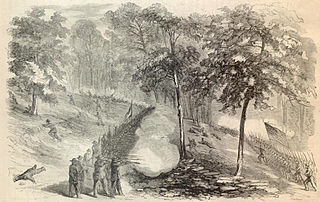Military
- Battle of Antietam, a major American Civil War battle
- Maryland Campaign, also known as the Antietam Campaign, an American Civil War invasion
- USS Antietam, three US Navy ships
Antietam /ænˈtiːtəm/ may refer to:

The Battle of Antietam, or Battle of Sharpsburg particularly in the Southern United States, was a battle of the American Civil War fought on September 17, 1862, between Confederate Gen. Robert E. Lee's Army of Northern Virginia and Union Gen. George B. McClellan's Army of the Potomac near Sharpsburg, Maryland and Antietam Creek. Part of the Maryland Campaign, it was the first field army–level engagement in the Eastern Theater of the American Civil War to take place on Union soil. It remains the bloodiest day in American history, with a combined tally of 22,727 dead, wounded, or missing. Although the Union army suffered heavier casualties than the Confederates, the battle was a major turning point in the Union's favor.

Sharpsburg is a town in Washington County, Maryland. The town is approximately 13 miles (21 km) south of Hagerstown. Its population was 705 at the 2010 census.

The Battle of South Mountain—known in several early Southern accounts as the Battle of Boonsboro Gap—was fought on September 14, 1862, as part of the Maryland campaign of the American Civil War. Three pitched battles were fought for possession of three South Mountain passes: Crampton's, Turner's, and Fox's Gaps. Maj. Gen. George B. McClellan, commanding the Union Army of the Potomac, needed to pass through these gaps in his pursuit of Confederate General Robert E. Lee's precariously divided Army of Northern Virginia. Although the delay bought at South Mountain would allow him to reunite his army and forestall defeat in detail, Lee considered termination of the Maryland Campaign at nightfall.

The Battle of Harpers Ferry was fought September 12–15, 1862, as part of the Maryland Campaign of the American Civil War. As Confederate Army General Robert E. Lee's Confederate army invaded Maryland, a portion of his army under Major General Thomas J. "Stonewall" Jackson surrounded, bombarded, and captured the Union garrison at Harpers Ferry, Virginia.
Monocacy National Battlefield is a unit of the National Park Service, the site of the Battle of Monocacy in the American Civil War fought on July 9, 1864. The battlefield straddles the Monocacy River southeast of the city of Frederick, Maryland. The battle, labeled "The Battle That Saved Washington," was one of the last the Confederates would carry out in Union territory. The two opposing leaders were General Jubal Early, fighting for the South, and General Lew Wallace, fighting for the North.

The Maryland campaign occurred September 4–20, 1862, during the American Civil War. Confederate Gen. Robert E. Lee's first invasion of the North was repulsed by the Army of the Potomac under Maj. Gen. George B. McClellan, who moved to intercept Lee and his Army of Northern Virginia and eventually attacked it near Sharpsburg, Maryland. The resulting Battle of Antietam was the bloodiest single-day battle in American history.

Antietam Creek is a 41.7-mile-long (67.1 km) tributary of the Potomac River located in south central Pennsylvania and western Maryland in the United States, a region known as the Hagerstown Valley. The creek became famous as a focal point of the Battle of Antietam during the American Civil War.
The American Battlefield Trust is a charitable organization whose primary focus is in the preservation of battlefields of the American Civil War, the Revolutionary War and the War of 1812 through acquisition of battlefield land. The American Battlefield Trust was formerly known as the Civil War Trust. On May 8, 2018, the organization announced the creation of the American Battlefield Trust as the umbrella organization for two divisions, the Civil War Trust and the Revolutionary War Trust, which was formerly known as "Campaign 1776."

Antietam National Battlefield is a National Park Service-protected area along Antietam Creek in Sharpsburg, Washington County, northwestern Maryland. It commemorates the American Civil War Battle of Antietam that occurred on September 17, 1862.
Monocacy may refer to the Monocacy River in Maryland, USA.

Battleground 5: Antietam is a 1996 computer wargame developed by TalonSoft in 1996, the fifth issue in the popular Battleground series.
The 13th New Jersey Infantry Regiment was a Union Army regiment from New Jersey that fought in the American Civil War.

Burnside's Bridge is a landmark on the Civil War Antietam National Battlefield near Sharpsburg, northwestern Maryland.

James Nagle was an officer in the United States Army in both the Mexican–American War and the American Civil War. During the latter conflict, he recruited and commanded four infantry regiments from the commonwealth of Pennsylvania and led two different brigades in the Eastern Theater. As the war progressed, worsening health problems precluded prolonged field service, but Nagle is perhaps best known for his actions at the 1862 Battle of Antietam, where his brigade played a key role in securing Burnside's Bridge, a key crossing over the contested Antietam Creek.
Hagerstown Valley is located in Maryland in the United States. It is part of the Great Appalachian Valley, which continues northward as Cumberland Valley in Pennsylvania, and southward as Shenandoah Valley in West Virginia and Virginia.
The 11th Ohio Infantry Regiment was an infantry regiment in the Union Army during the American Civil War.
The 16th Connecticut Infantry Regiment was an infantry regiment that served in the Union Army during the American Civil War.
The 48th Regiment Pennsylvania Volunteer Infantry, the "Schuylkill Regiment", was an infantry regiment of the Union Army during the American Civil War.
The 3rd Regiment Maryland Volunteer Infantry was an infantry regiment that served in the Union Army during the American Civil War. It was noted for its holding the high ground at the center of the line at Antietam as part of Stainrook's 2nd Brigade, Greene's 2nd Division of Mansfield's XII Corps.